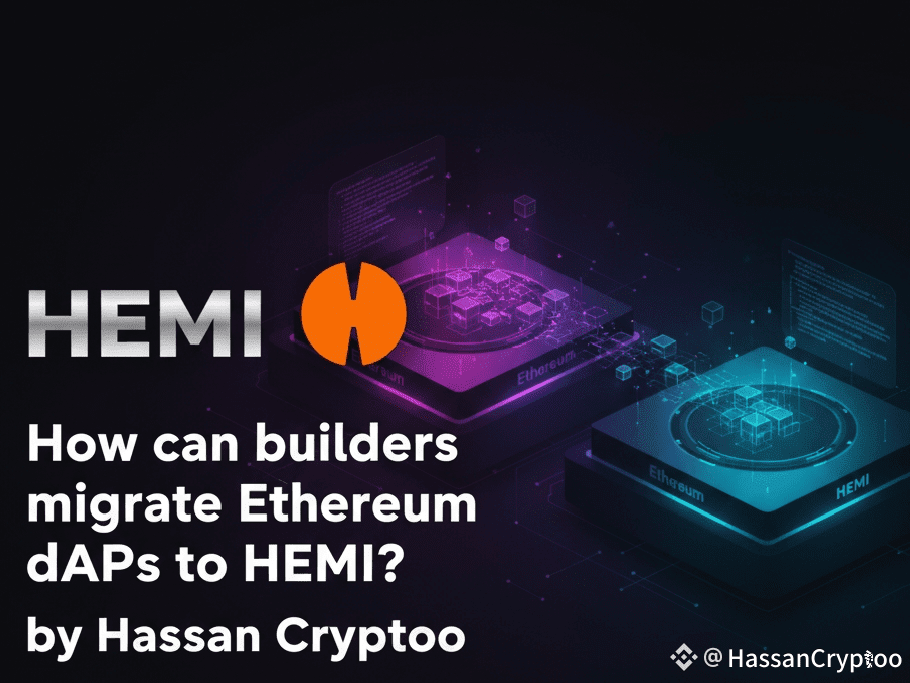Introduction:
Migrating your Ethereum dApp to @Hemi | $HEMI isn’t just a technical shift. it’s an opportunity to access new users and features. HEMI combines Ethereum-style tooling with a Bitcoin-aware ecosystem, so you can reuse most of your code while unlocking new capabilities. This guide gets straight to the point, outlining the steps, checks, and common pitfalls to avoid.
Why Move to HEMI?
HEMI lets you stick with the Ethereum tools you’re comfortable with wallets, dev environments, and more while making it simple to read Bitcoin data or move value across chains. You can keep building with a familiar stack but reach Bitcoin-oriented users and those after lower fees. If you want to grow your app’s audience or add Bitcoin-native features, HEMI makes it possible without rebuilding everything.

Start with a Clear Plan:
Don’t just jump in. Decide what you want from the migration. Are you aiming for cheaper transactions? Want your dApp to react to Bitcoin events or hold Bitcoin directly? Sketch out a straightforward plan. Figure out which parts of your app will move, what remains on Ethereum, and how users will interact with both.
Audit Your dApp: What Needs to Change?
Review your contracts and UI carefully. Most Ethereum contracts work on HEMI since the coding style is similar. But if your code relies on Ethereum-specific oddities or external Ethereum services, you’ll need to adjust it. Your UI will likely need a network switcher so users can pick between HEMI and Ethereum.
Lean on Familiar Tools:
HEMI’s tooling is just like what you use on Ethereum. There’s no need to learn a new process. Point your dev setup to $HEMI test nodes, deploy contracts to a HEMI testnet, and run your usual tests. This keeps the learning curve short and helps you catch problems early.
Move Assets and Tokens Carefully:
If your dApp handles tokens, safe asset transfer is crucial. HEMI’s tunneling tools let you move tokens between Ethereum and HEMI. Make the process clear show estimated fees, wait times, and encourage users to test with small amounts first. Never transfer large sums until you’ve tested everything end to end.
Test Everything on HEMI Testnets:
Don’t skimp here. Make a solid test plan. Deploy to a HEMI testnet, run your unit tests, and check every user flow. Try edge cases: interrupted transfers, low gas, price changes. Bring in trusted testers before opening to the public.
Keep the User Experience Simple:
No one likes confusion. Make it clear which network users are on, how to bridge assets, and what fees to expect. Offer clear, simple instructions and direct links to official bridges or tunnels. Let users easily switch between Ethereum and HEMI in your app.
Stay Smart About Security:
Don’t cut corners on security. Follow best practices—get your contracts audited, set up monitoring and alerts, and consider a bug bounty. Limit contract approvals and avoid unlimited permissions. Have upgrade and emergency pause plans ready, just in case.
Plan Your Rollout and Liquidity:
Start slow. Roll out core features first, keeping riskier ones behind feature flags. If your app depends on liquidity, coordinate with partners so enough is available on HEMI at launch. Set clear expectations around fees and liquidity for your users.
Prep for Support and Community:
Be ready to answer common questions: bridging tokens, transfer times, wallet recovery. Prepare concise help docs. Connect with the HEMI developer community for tools, advice, and feedback. Good documentation and support build trust and reduce your support load.
Track Metrics and Keep Improving:
After launch, monitor your metrics: transaction success, average fees, bridge times, user retention. Let the numbers guide you. Fix pain points slow waits, confusing UI, high fees. Keep refining for a smoother experience.
Conclusion:
Moving your dApp to $HEMI is efficient most Ethereum tools and contracts work out of the box. You unlock new ways to connect with Bitcoin and broaden your audience. With careful planning, thorough testing, clear user guidance, and strong security, you can migrate confidently and deliver a better experience overall.
Disclaimer:
The content I share as a Binance Square creator is for informational and educational purposes only and should not be construed as financial, legal, or investment advice. Cryptocurrency markets are highly volatile and carry significant risk. Always do your own research (DYOR) before making any trading or investment decisions.
By Hassan Cryptoo

